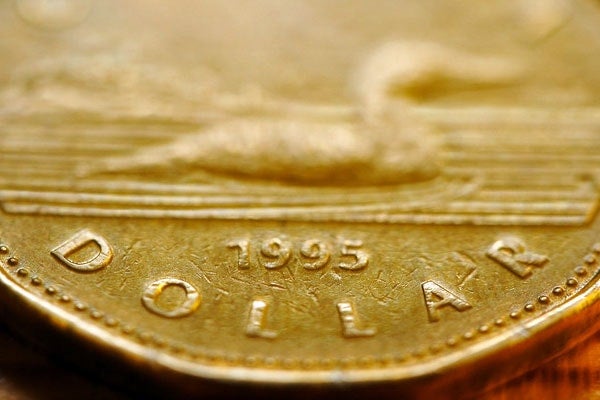
Canada's economy: should forest fires, drought, oil spills and a decline in the dollar make you worried?
Published: July 23, 2015
The Canadian dollar sank to its lowest level in more than a decade this week and across the country the news making headlines included drought, forest fires, oil spills and increased demand at food banks.
But when it comes to Canada’s future, economic forecaster Peter Dungan is optimistic – even if the dollar dips lower in the short term.
Dungan is an adjunct associate professor of business economics at the University of Toronto's Rotman School of Management with cross-appointments at the department of economics and the School of Public Policy and Governance. He heads up a policy and economic analysis group at Rotman which develops economic forecasts for Canada and Ontario. The forecaster reminded U of T News writer Noreen Ahmed-Ullah that, back in the mid-1990s, the dollar was even lower than it is now.
How does Canada’s economy compare with the rest of the world where many countries are currently struggling with recession?
First of all, the U.S. is not struggling with recession.One of the bright things on the horizon for us is the American economy is coming along fairly well, and as our major trading partner, that’s good news for us especially with the dollar being lower.
The only thing that people have to keep in mind is that when the dollar drops several cents, it doesn’t mean the Canadian business picks up the next day. It takes even conservatively a half a year or more for the effect of the lower dollar to show up in increased activity in exporting. And we can’t forget that when imports become more expensive, Canadian producers also get a benefit because they get to sell more to Canadians. So those sorts of things are going to affect the economy fairly strongly.
In terms of our outlook, we are still fairly optimistic for the end of this year and on into 2016 because of the lower dollar and because of the strength of the American economy. Yes, it’s too bad that Japan is weak and that Europe is weak, and they’re going to be weak for a while. We think the China situation has pretty much bottomed out, and although they’re not going to get roaring back to 10 per cent growth any time soon, the fact that they’re still growing at 7 per cent is still a strong boost for things in the longer term.
Western Canada’s been hit particularly hard with natural and environmental crises like forest fires, drought and even the oil spill in Alberta. Will that hurt the Canadian economy even more?
Most of those kinds of things aren’t even on the radar screen for major forecasters. Of course, they matter for the regions or the towns and possibly even the province. But nationally, these things tend to be small in size compared to things like the movement of the dollar, the movement of oil prices or another big thing that’s starting to happen is the big payout from child benefits that’s coming from the federal government. That we expect will be a positive for the Canadian economy in the third and fourth quarters – people will spend some of that money because it’s quite a chunk of change that’s coming down, and it dwarfs things like what’s being spent to fight forest fires.
We had the same kinds of questions occur during the ice storm in Toronto a couple of years ago: “Oh, how much is that going to affect the GDP?” It’s barely noticeable. The thing I worry about is the environmental concerns with the tar sands or oil sand – to have a pipeline spill when people are negotiating how to get a pipeline to get the oil from the oil sands out, that can’t have been a great thing. In terms of its impact, the spill is inconsequential. Something that would cause further development of the oil sands to be held back, that’s where the big impact will be. And that will show up as lower investment in oil sand exploitation over the next year or so.
What could turn the dollar around?
An increase in oil prices would do the trick, very quickly. In the long term, a lot of people think that will happen. If you look at the futures market for oil, they still have oil at $60 a barrel into 2016, and $80 a barrel when you’re looking forward to like 2018, 2019, 2020. The general feeling is that the relative scarcity of oil that pushed the dollar price well over $100 just a year ago, will still reassert itself in the long haul as Europe starts to grow again, as China starts to grow again, as the American economy strengthens up. But it would be a long time before it ever got as high as $100 a barrel again because you have new production coming on stream like fracking in the United States and Iran will start to produce more as well.
But it’s going to be quite choppy. If anything when it got to $60 a barrel a few weeks ago, that was almost premature. It was faster than the futures markets had anticipated, but now it’s into the high 40s, and it looks like it will stay there for a while. So the Canadian dollar is going to stay low for a while, but our own forecast has the dollar gradually appreciating again as the oil price goes up.
Would that affect drivers?
Probably not. It’s funny the lower oil price hasn’t moved much into Canadian dollar prices of gasoline yet, partly because the Canadian dollar fall has offset the U.S. dollar price decrease per barrel of oil. In other words, if the oil price falls 10 per cent but our Canadian dollar falls 10 per cent, those wipe each other as far as the Canadian dollar price of gasoline goes. But if they both rose in the future, they would wipe each other out again. So there isn’t a huge change in gasoline prices.
What else can help the dollar?
The other thing that’s moved the dollar is that our central bank has decided to become looser, that is it’s lowered interest rates. We have to remember our interest rates are higher than the United States. But the big expectation now is ours won’t rise, theirs will and so the interest rate differential between the two countries will close even further. The money moves to where the interest rates are relatively higher. So it’s moving out of Canada now relatively speaking, and that’s part of what’s pushing the dollar down.
To the extent that in a year or two that stops happening, that our interest rates start to rise with the American rates because our economy is improving, then that part will also pull the dollar up again. So it is possible that the dollar will go lower in the shorter term. It all depends upon oil prices and the relative strengths of the U.S. and Canadian economies, but our general expectations for the longer term it’s not going back to parity any time soon, but it will go back into the 80s in a year or two.



